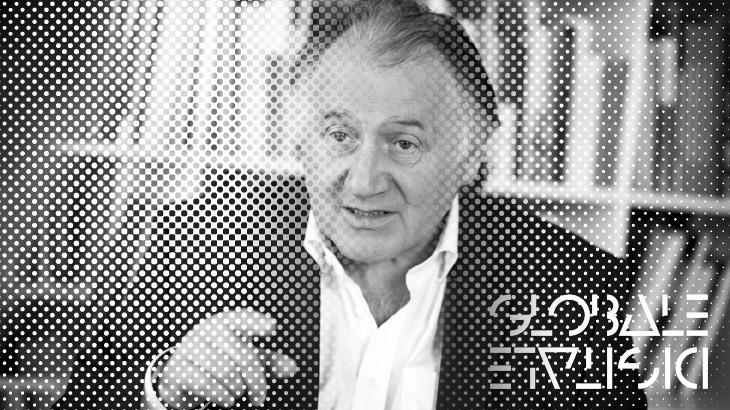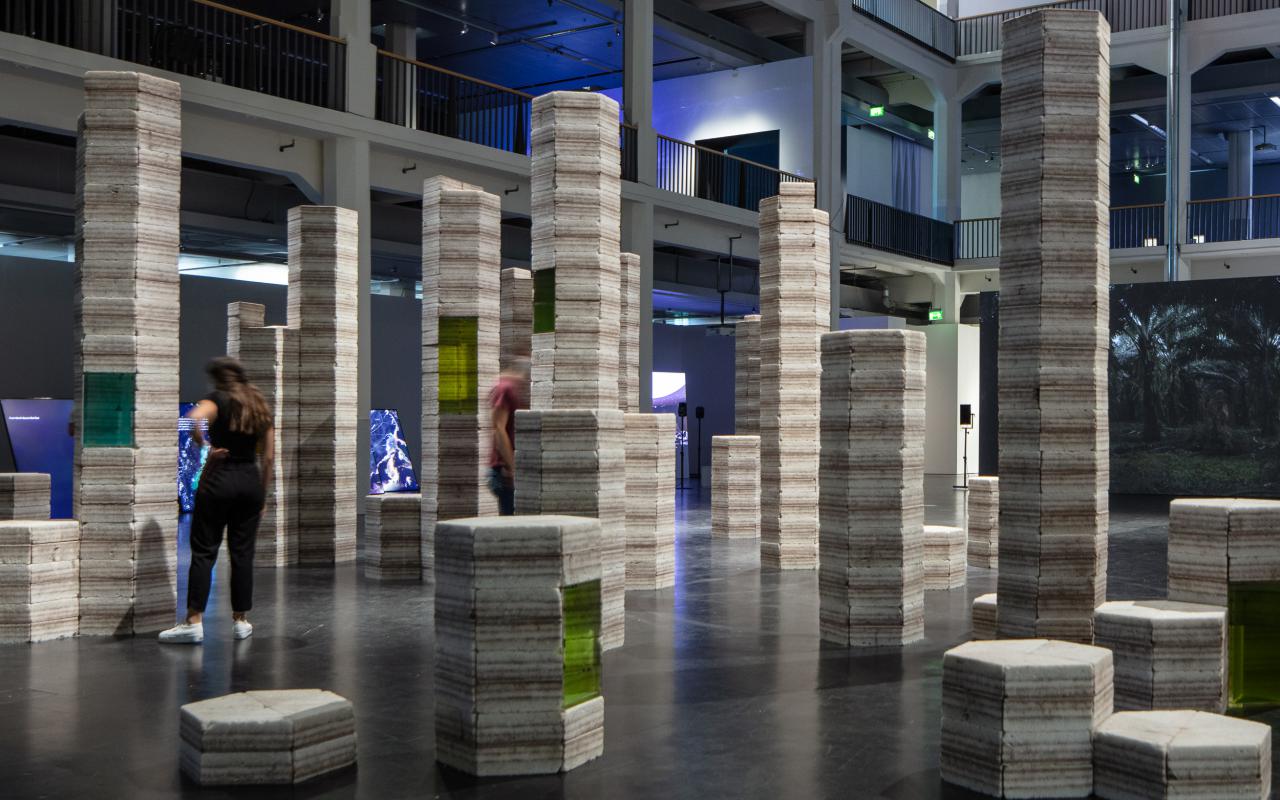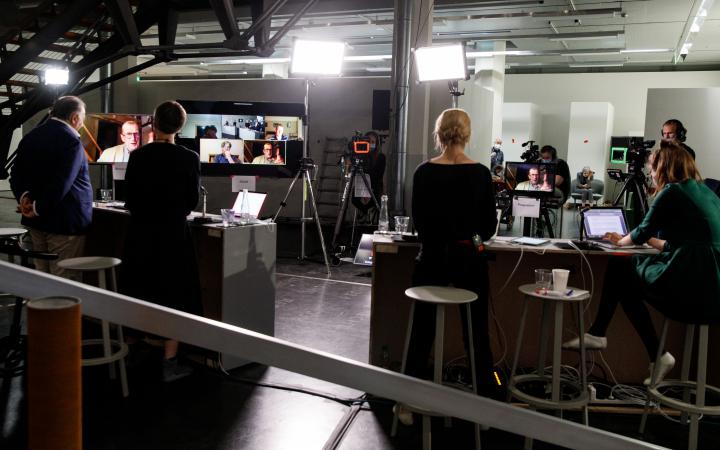
2015-05-13
Asylum in New Athens
Peter Weibel outlines the concept of GLOBALE in an interview with Matthias Kampmann.
Matthias Kampmann: Where do you see the task of »GLOBALE« as an event format within the scope of a city anniversary? How is the ZKM incubating the anniversary? And what role does art play?
Peter Weibel: The art exhibition formats have remained relatively unchanged from the tents of the Salons des Indépendants in the 19thcentury up to the museum’s »White Cube« in the 20thcentury. The performative shift also reached the exhibition halls with the emergence of media art, which calls for the viewer’s participation and interaction, and the forms of action art (body art, actionism, happening, fluxus, performance and live art). As long as art was only exhibited as a two-dimensional or three-dimensional object, the classic exhibition formats were sufficient for the exhibition artist[1]. In the historic moment as arts expanded in terms of becoming performative and operative, the classic exhibition formats were perceived as a limitation. That is why the ZKM | Center for Art and Media Karlsruhe understood dance, performance and music as essential parts of its performance and exhibitions practice and included these components in the program from the start. In the exhibition »net_condition« (1999/2000), we experimented with online formats and »virtual dependencies«, and with Boris Charmatz (»Moments. A History of Performance in 10 Acts«, 2012) and Sasha Waltz (»Sasha Waltz. Installations Objects Performances«, 2013/2014), we experimented with theatrical and dance-like formats. Today museums such as the Tate Modern and the MoMA are also starting to develop their own formats for performances. Even the Art Basel art show exhibited live art, albeit in closed rooms. Conversely, theater is starting to open up to performative forms of art. In the exhibition »The Global Contemporary. Art Worlds after 1989« (2011/2012) and with numerous symposiums, for about six years the ZKM has at the same time asked the question as to why there are hundreds more biennials worldwide nowadays than twenty years ago.
In the age of digitalization and globalization, and in particular due to altered practices of visual arts as well as the alteration of theater and dance, new events formats are urgently required. The polyphonic and multipolar manifestation »GLOBALE« is the sum of the ZKM’s experiences and its observations of the global art scene and culminates in the requirement to develop an appropriate presentation format for the contemporary, most advanced art practices which are performative, live, online and digital, etc.
Nowadays artists work in space as well as in the deep sea, and render works of art on several continents simultaneously. Their studios resemble the laboratories of scientists. Scientists open up speculative visions ranging from genetic engineering to energy generation. Artists are interested in similar topics. This gives rise to interfaces and overlaps as well as confluences and convergences for which a specific architecture of space as well as time must be developed. Theaters, museums and opera houses, but also scientific academies face a difficult period of transition because the previously separated realms of work are blending and expanding due to new practices of artists, but also scientists. Museums must take on much more functions than previously because to some extent they become a place of exile, a haven for banned and displaced visions or visions which are not yet recognized. If the sphere of politics continues to do things as in the past and the Church also fails, in the future migrants will no longer seek asylum in churches, but in museums. The ZKM is already prepared for this.
»GLOBALE« is polyphonic because we have invited several curators from different cultures to rethink the modern age: Bruno Latour from Europe, Pan Gongkai from China and Yuko Hasegawa from Japan. This occurs in a spectrum of scenographic, choreographic and scientific works. Siegfried Zielinski will present »Allah’s Automata«, which were built around 1000 AD, i.e. the voice of Arabia at the beginning of the modern scientific era. Musical events such as »Global Bass« with DJ Spooky will deal with an international trend. At the beginning of »GLOBALE«, a theatrical tribunal will conduct a trial against crimes in the 20th century, and scientists and artists will propose solutions for the 21st century entitled »Next Society« at the end of »GLOBALE«. To be precise, we need new institutions and initiatives so that we do not repeat the transgressions of the 20th century. The effects of the digital revolution will be presented in a series of alternating events and exhibitions under the title »Infosphere«, and the effects of new »maker culture« and »engineering culture« phenomena will be presented by great artists within the scope of »Exo-Evolution«. We will also alter the cityscape of Karlsruhe itself with performative actions and sculptures. At the moment, Karlsruhe is a gigantic construction site, to some extent occupied by construction companies. In this respect I would like to intervene against this with a type of »construction site art«. We will also visually transform the facade of Karlsruhe Palace with new projection techniques such as video mapping. For three months there will be repeated façade projections which will also be interactive, i.e. require audience participation.
We appeal to Karlsruhe’s liberal tradition and the Baden Revolution of 1848/1849 with topics ranging from »citizen artists« to »citizen scientists«. Karlsruhe is regarded as the »seat of justice« with its three judicial institutions. As a result, it is the ideal place to debate the constitution of the future. Two inventions or discoveries which massively influenced the world were made in Karlsruhe, namely the mobility of machines and the transport of people and goods by automobiles (by Carl Benz in 1886) and the mobility of media as well as the transport of data by wireless radio technology (by Heinrich Hertz; 1886–1888). Globalization and digitalization ensued as a result. That is why Karlsruhe’s 300th birthday is the ideal place and occasion for »GLOBALE«. A minor personal comment: I always dream of the utopia of a virtual, decentralized geography of power. That is why I am for federalism and the support of the periphery, for the sites on the margins of the republic. As far as I am concerned, Berlin is the city of »Infinite Jest«[2]. In the edition of »The New Yorker« magazine from December 2014, George Packer is not without reason surprised about »The Quiet German in Berlin«. Karlsruhe promises ‘tranquility’ (»Ruhe« in German) in its name, but due to its history, contemporary institutions and great living personalities who have an effect here, Karlsruhe repeatedly causes a stir. For instance, the Sunday edition of the »Frankfurter Allgemeine« newspaper known as »FAS« (dated Dec. 02, 2012) surprisingly posed the question regarding whether Karlsruhe is the »new Athens«. I maintain that Karlsruhe is at least the capital of the »Educational Republic of Germany«.
What role does art play with regard to »GLOBALE«? This is a question like: What role does democracy play? And the answer depends on what a person expects from democracy or art! If, like many people, you are of the opinion that art is a trophy for oligarchs or is part of the supplier industry for haute couture ranging from Armani to Louis Vuitton and from Prada to Pinault, who now all have their own highly decorated museums, i.e. art is part of the luxury goods industry, or if you view art as a new form of tax evasion, then art does not play a role with this context of »GLOBALE«! We hardly exhibit any representatives of »market art« and »auction art«. We exhibit art of the 21st century. Most museums do not even exhibit art of the 20th century. They »train« the audience to love art of the 19th century by orienting themselves to the »supposed« taste of the audience. We have neither fear of the audience nor of contemporary art, because we do not scorn the audience like television does and therefore provides only trash! We assume that the audience is also not afraid of contemporary art, if they would only be shown such art, and contemporary art is infinitely more than market and auction art, the »blind carousel« of names that are always the same! From »sound art« which is not played in concert halls, via science-based art experiments which are technically too difficult to realize for museums, to scientific visions which are too speculative for academies, the most important trends in art and science of the 21st century will be exhibited at »GLOBALE«!
Art runs the risk of taking itself out from the social play of by hiring itself out as a maidservant of the market and the entertainment industry. In contrast, science has gained such prestige that nobody dares to doubt its extremely highly subsidized existence. This also has to do with the fact that the current key term is »innovation«, like »growth« was for the 20th century and »evolution« was for the 19th century. Art has contributed relatively little to all these key terms. That is why it no longer plays the role which it once had and which it imagines. Market-dominating art asks neither the right questions nor gives the right answers. Now we are experiencing the awakening of a new generation of artists which is seeking new avenues for art, turning away from entertainment and turning towards experimental scientific systems. In addition, it behaves media-critical and politically alternative. That is why we can speak of a »Renaissance 2.0«!
MK: If we »build« the future, Karlsruhe is a nice example. After all, hardly any city has been »built« in such a manner, since most cities »grow«. What could the slogan »building the future« mean for Karlsruhe today? How is the ZKM helping to build the future?
PW: In fact, Karlsruhe is a city designed on a drawing board, the famous fan-shaped city with the Palace as the center and radial sectors. Built according to a plan, Karlsruhe is now faced with the paradox that in the era of information and communications technology which has essentially characterized Karlsruhe, this type of historic construction is no longer on a par with »building the future«. In addition to the constructed architecture, a global virtual architecture has emerged in the age of digitalization through the Internet and social media. Digital networking creates a parallel, virtual geography in which the center is equally ranking with the periphery. In particular, Karlsruhe is one of Europe’s Internet capitals. It was chosen in a ranking as the fourth most important Internet city after Munich, Paris and London. So Karlsruhe would have to make an effort to transfer the media and data-based spatial experience of the Internet age back to reality, a decentralized, virtual architecture. Karlsruhe should look like the digital branch of itself. So Karlsruhe could be a model city for the future of construction if it takes into account thermodynamic, ecological parameters. Karl Steinbuch wrote the first work on »Die informierte Gesellschaft« [The Informed Society][3] in Karlsruhe, and the only still functioning ZUSE 22 computer is housed at the ZKM. We owe the masterpiece »Rechnender Raum« [Calculating Space][4] to Konrad Zuse. Karlsruhe as a calculated city means building a new form of the future. The ZKM exhibitions ranging from »Algorithmic Revolution« (2004) to »Making Things Public« (2005) as well as the »Intelligent Buildings« (1989) conference at the former Technical University of Karlsruhe (now Karlsruhe Institute of Technology) have already provided the fundamentals.
MK: You spoke of an evolution of art or the continually progressing extension of mankind, whose space will be the Infosphere. Have we already achieved that? And how is that reflected with regard to »GLOBALE«?
PW: The natural evolution has created organs such as the hand, eye and lungs. These organs are to some extent evolution’s answers to the sun and atmosphere. The hand is undoubtedly regarded as one of a human’s first tools. But with this natural tool man was able to make other tools which are not from nature, but made by him. Metaphorically speaking, one could say that a culture of tools emerged from a technical »outsourcing« – externalization – of natural human organs. The hammer emerged from the hand, the wheel from the foot and so on. These tools have improved, expanded, corrected and finally even replaced the functions of natural organs. Eyeglasses correct defects in the natural retina. The prosthesis replaces the missing leg. Man emerged from natural evolution with self-created tools ranging from microscope to microphone. Today we speak of an exoskeleton that performs the work of a bad spine outside the human body. In this sense, eyeglasses are an »exo-eye«, the hearing aid an »exo-ear«, and all storage media are an »exo-memory«, etc. Exobiology pursues the search for life beyond Earth, and we look for planets – exoplanets – beyond the known galaxies. Machinery and media are technical extensions of organs. »Exo-Evolution« constitutes the sum of these tools. We retrospectively recognize that the organs are tools, but natural tools which evolution has given us. Among the mysteries of evolution is that we have developed organs for light and air, but not for magnetism and electricity, although these phenomena have already existed longer, namely since the origin of the universe. We only discovered the existence of magnetism through the compass needle. The Earth was only discovered as a magnet four hundred years ago. Faraday only discovered the connection between electricity and magnetism in the middle of the 19th century, and Maxwell described it with his famous formulas. Heinrich Hertz provided the existence of electromagnetic waves and that light consists of electromagnetic waves. His radio experiments at the time established the fundamentals for wireless radio technology ranging from telephone to radio and from television to Wi-Fi. Man did not have natural organs for the reception of these electromagnetic waves, but he had to create artificial organs outside the body for this purpose (radio, telephone, television, satellite broadcasting, antennas, GPS systems, etc.). By means of Exo-Evolution we have utilized the shell of electromagnetic waves which surrounds the earth similar to the atmosphere. I called this new sphere Infosphere for the first time during a lecture in 1986 (»Beyond the Earth«). The word has become common in the meantime. There is even a book entitled »The 4th Revolution. How the Infosphere Is Reshaping Human Reality«[5]. The Earth with its atmosphere is the living space created by evolution for humans. With the Exo-Evolution created by humans, he has created a global digital branch: the Infosphere. Man now lives in two habitats, two spheres: as a biological being in the atmosphere, as a social being in the Infosphere. If you imagine, even today mating behavior needs the Infosphere with »Parship« and similar online dating services. Seven billion humans could not live on the globe if we could not organize the transport of data, goods and people at minute intervals with the help of the Infosphere. We definitely already live in the realm of the Infosphere. Evolution has created the atmosphere, and Exo-Evolution has created the Infosphere. All four factors influence each other and – it is hoped – will contribute towards solving present crises ranging from climate crisis to financial crisis. »GLOBALE« will exhibit new artificial life forms and materials with new properties, ranging from the maker culture of 3D printers via nanomaterials to genetic engineering.
MK: Given that we are already living in the Infosphere (if nothing else, activities of the German Federal Intelligence Service (BND) and the American National Security Agency (NSA) indicate that), how must someone who is not a digital native, and yet would still like to understand their environment, change?
In the Infosphere exhibitions we will also present the dark side of technology, namely possibilities of control and surveillance. As is generally known, everything is a creative industry nowadays. The NSA is also creative, it creates suspicion!
In 1930, Frank Lloyd Wright described the modern age spawned by the Industrial Revolution with the equation »Machinery, Materials, and Men«. This equation will continue to hold true. As a country of machine builders and motors, Germany is a champion in the interpretation of this equation. But in the worldwide rankings of large companies and large turnovers, the automotive industry has slipped far below, and Internet companies such as Apple and Google are among the first ten. From this I derive the supposition that the equation for the 21st century is »Media, Data, and Men«. Europe merely plays the role of consumer in this equation. Software is predominantly programmed in America and hardware is built in Asia. Even Nokia has gone down. Europe is merely the end consumer in the value-added chain of the digital age. If Europe does not spend billions of euros to attain digital sovereignty, it will be colonialized by America and Asia, and become a continent of digital slaves.
MK: What is your most important (artistic) concern that is associated with »GLOBALE«?
PW: My most important concern with regard to »GLOBALE« is firstly articulated in the Gospel of Matthew: “Blessed are those who hunger and thirst for righteousness, for they shall be filled” (Matthew 5:6). This is the promise of democracy, but because it is so unrealistic it will be postponed until the end of all days, the Last Judgment. After the death of perpetrators and victims, God will mete out justice. I am for a secularization of the notion of justice.
My second concern with regard to »GLOBALE« is to demonstrate that the epoch of absolute disinhibition that we call the modern age and its absolute, individual expressionism is coming to an end. The global signs cannot be overlooked. Artists refer to scientific parameters. Their reference system is no longer solely religion and art history, but also natural science. Artists want to have a share in the construction of the world and not only describe or depict the world. That is why there are increasingly greater overlaps of tools which scientists and artists share. That is why science and art are drawing closer together again, even if the objectives are different. This is a process which we were lastly able to observe in the 17th century, the »Siècle d’or«, and in the Renaissance.
Literature
[1] Oskar Bätschmann: Ausstellungskünstler. Kult und Karriere im modernen Kunstsystem. Köln (DuMont) 1997)
[2] David Foster Wallace: Unendlicher Spaß [Infinite Jest]. Reinbek (Rowohlt TB) 2011/1996)
[3] Karl Steinbuch: Die informierte Gesellschaft. Stuttgart (Dt. Verlagsanstalt) 1966
[4] Konrad Zuse: Rechnender Raum. Braunschweig (Friedr.Vieweg + Sohn GmbH) 1969, Rechte heute bei Springer, http://link.springer.com/book/10.1007%2F978-3-663-02723-2
[5] Luciano Floridi: The 4th Revolution. How the Infosphere Is Reshaping Human Reality. Oxford University Press 2014
Appearing on the German-language website weisskunst.de Kunst, Kritik und Computer (weisskunst.de | Art, Critique and Computer)


